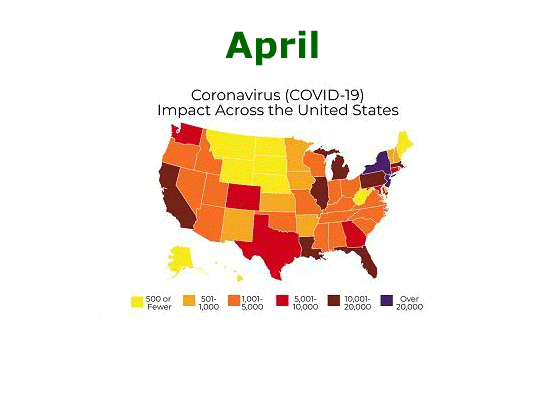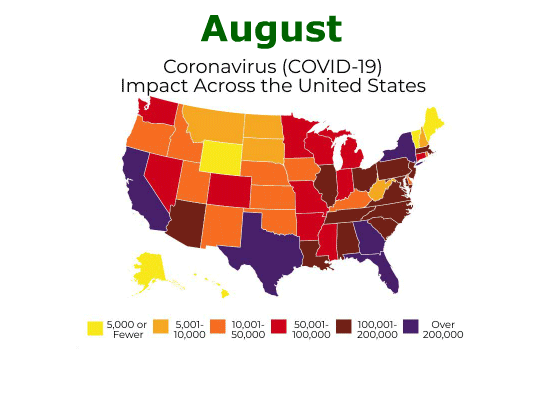After over a year of tracking the COVID-19 pandemic’s impact on the U.S., we will be sunsetting our interactive map of cases on Thursday, June 3. Read on for our final update to the map, a list of resources, plus animations showing how our map developed over time. We encourage readers to visit our map’s data source, the Johns Hopkins University & Medicine Coronavirus Resource Center, for detailed data.
Our interactive COVID-19 case map originally launched on March 16, 2020, and after some frequent adjustments in the first few weeks of the pandemic, on April 7 we finally settled on a range that we thought would cover a worst-case scenario—with our darkest purple color denoting a state with 20,000 or more cases.
To put that in perspective, if this original legend were still in use as of February 2021, Vermont would be the only state not purple (and as of June 2021, when our final update was made, Vermont would have been purple, too). For additional context, the below animation shows how our original interactive map developed between April 7 and August 7, 2020.
However, even an uppermost range of over 200,000 cases would prove to be insufficient. The second animation below shows how our revised map developed between August 12, 2020, and January 31, 2021.
Our new map below (released on February 4, 2021, and final update made on June 3, 2021) yet again increased the numbers within the legend tenfold, with the lowest range set at 50,000 or fewer cases and the highest at over 2,000,000 cases.
The numbers have been staggering. But COVID-19 vaccines and stronger OSHA guidance that proactively sought to address the health and safety threat posed by the pandemic have brought us to the point where we can now begin returning to some semblance of what we remember as “normal.”
As we look ahead to life after COVID-19, EHS professionals must still consult reliable resources; here is a short list to help.
- Check out the EHS Daily Advisor’s COVID-19 articles as well as BLR’s Coronavirus Response Center.
- Track COVID-19 updates from the Occupational Safety and Health Administration (OSHA).
- Visit websites for the Centers for Disease Control and Prevention (CDC) and the National Institute for Occupational Safety and Health (NIOSH).
- The National Safety Council’s (NSC) Safe Actions for Employee Returns (SAFER) initiative provides a wide variety of guidance for employers.
- The American Society of Safety Professionals (ASSP) also has a COVID-19 resource center.
For more detailed data specific to your area and worldwide, visit our map’s data source, the Johns Hopkins University & Medicine Coronavirus Resource Center.
Thank you, and stay safe!
(Editor’s Note: The final update to the map was made on Thursday, June 3, 2021.)
Data source: Johns Hopkins University & Medicine’s Coronavirus Resource Center, which pulls data from WHO, CDC, ECDC, NHC, DXY, and local media reports



